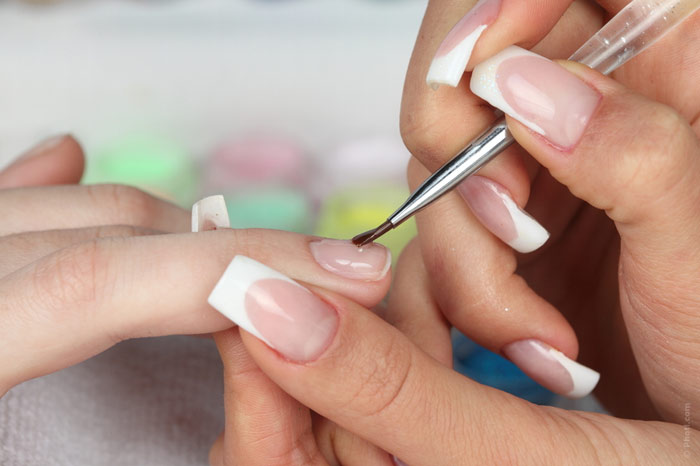Gel looks luxurious on nails! And it lasts long. However, all the advantages of acrylic nails are outweighed by the troubles arising afterwards. This type of manicure leaves nail plates dry, scaly and thin. They need special rehabilitation.

Our nails are composed of cells called keratinocytes. When viewed under a microscope, these cells look like tiles on the roofs of houses, clinging to the nail plate only on one side. When you remove acrylic manicure, the upper layers of the cells, come off, too. That is why nails peel, become uneven and patchy after such manicure.
You will need several weeks to fully restore the nail plate. Follow the tips that will reduce the time of rehabilitation:
1. Polishing
To prevent further destruction and peeling, nails need polishing. This should be done as gently as possible, using a high-quality fine file. The recommended frequency of polishing is 1-2 times a week. There is another plus in polishing: the process increases blood circulation, which helps to quickly grow new, healthy nails.
2. Giving up nail enamel
Nails need time to heal and recover. Meanwhile, it is better to give up nail polish. Instead, use natural products, strengthening the nail plate. These are products with biotin and oils (e.g. safflower oil), which are called Strengtheners. They look like transparent nail polishes and should be applied regularly instead of enamels. These products contribute to nail restoration, moisturizing and strengthening protein connections. You should give up your nail polish for 1-2 weeks.
3. Creating the correct form
Nails become very fragile after acrylic manicure. One wrong move can lead to painful cracks and damage. Try to keep your nails as short as possible during rehab. Their shape should be round, so that the nails will not cling to the surrounding objects. When you trim and file your nails, do it in one direction. In addition, use a very fine file.
4. Take care of the cuticles without cutting them
Give up the nippers when caring for cuticles. Your cuticles protect the new nails growing out of them, so they should be left intact. However, you can move them aside with an orange tree stick. Use cuticle oil – it can be used very often, even every hour. More intensive care is provided by cuticle serum and cuticle gel.
5. Moisturizing
One of the most important ways of recovery after acrylic manicure is moisturizing. To do this, use hand cream with protein peptides and nutritional antioxidants. Re-apply the cream on your hands as often as possible. At night you can wear gloves – the recovery will go faster. Do not forget to protect your hands when washing the dishes: hot soapy water dries your hands and nails.
6. Nail compresses
Weekly compresses help with nail rehabilitation. A good option would be whole milk because it contains a lot of fat needed for nails. You can slightly warm it, moisten a cotton cloth in it and wrap it around the nails for a few minutes. Alternatively, make a milk bath.
It is useful to make an oil bath once a week. Heat some olive oil (or grape seed oil), add a capsule of vitamin E and soak your fingers in the bath for 10 minutes.
7. Healthy diet
Recovery should go not only from the outside but also from the inside. This means that proper nutrition can help to solve your problem. Nails are made of protein, and, to stimulate their growth, you need a diet rich in protein, calcium and omega-3 fatty acids. In addition to this, take vitamin complexes specially designed for strong nails and containing biotin, gelatin, essential vitamins and minerals.
8. Salon treatment
If your nails turned out to be in very poor condition, it is better to seek help from a professional. Find a salon, which offers nail intensive treatment and conditioning. Such treatments use heat, which facilitates the penetration of a special recovering serum into upper nail layers. Heat helps the serum to penetrate and fill all the microscopic cracks on the surface of the nail.










